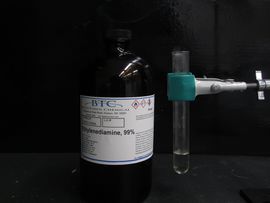Ethylenediamine
 |
This article is a stub. Please help Sciencemadness Wiki by expanding it, adding pictures, and improving existing text.
|
 Ethylendiamine fuming in air
| |
| Names | |
|---|---|
| IUPAC name
Ethane-1,2-diamine
| |
| Preferred IUPAC name
Ethane-1,2-diamine | |
| Systematic IUPAC name
Ethane-1,2-diamine | |
| Other names
1,2-Diaminoethane
Edamine | |
| Properties | |
| C2H8N2 | |
| Molar mass | 60.10 g/mol |
| Appearance | Colorless liquid |
| Odor | Ammonia-like |
| Density | 0.9 g/cm3 (20 °C) 0.898 g/cm3 (25 °C) |
| Melting point | 8 °C (46 °F; 281 K) |
| Boiling point | 116 °C (241 °F; 389 K) |
| Miscible | |
| Solubility | Reacts with mineral acids, carboxylic acids Miscible with alcohols, ethers, esters |
| Vapor pressure | 1.3 kPa (at 20 °C) |
| Thermochemistry | |
| Std molar
entropy (S |
202.42 J·K−1·mol−1 |
| Std enthalpy of
formation (ΔfH |
−63.55–−62.47 kJ/mol |
| Hazards | |
| Safety data sheet | Sigma-Aldrich |
| Flash point | 34 °C (93 °F; 307 K) |
| Lethal dose or concentration (LD, LC): | |
| LD50 (Median dose)
|
500 mg/kg (rat, oral) 470 mg/kg (guinea pig, oral) 1,160 mg/kg (rat, oral) |
| Related compounds | |
| Related compounds
|
Ethylamine |
| Except where otherwise noted, data are given for materials in their standard state (at 25 °C [77 °F], 100 kPa). | |
| Infobox references | |
Ethylenediamine is an organic compound with the formula C2H4(NH2)2, and is often abbreviated en when used as a ligand. It is a common ligand in coordination chemistry and a ubiquitous chemical building block in organic synthesis. It is volatile, but tends to form a mist in air, which is quite toxic.
Contents
Properties
Physical properties
Ethylenediamine is a clear, colorless liquid at room temperature. It freezes at 8 °C and boils at 116 °C, both of which are close to the melting and boiling points of water. It has an ammonia-like smell, and its vapors are extremely irritating, which can fume in air. It is miscible with water at all concentrations.
Chemical properties
Ethylenediamine is a powerful chelating agent and will readily complex to many metal ions, notably, cobalt, nickel, copper, and chromium (with some difficulty). The stability of these complexes is due to an increase in entropy by freeing 2 monodentate ligands per complexed ethylenediamine molecule.
Energetic materials can be made with ethylenediamine and metal perchlorates, most notably tris(ethylenediamine)nickel perchlorate and bis(ethylenediamine)copper(II) perchlorate.
Availability
Ethylenediamine is sold by chemical suppliers.
Preparation
Ethylenediamine is manufactured industrially by reacting 1,2-dichloroethane with ammonia under pressure, at 180 °C in an aqueous medium. This process is complex for the amateur chemist.
Projects
- EDTA synthesis
- Make various complexes
- Make tris(ethylenediamine)nickel perchlorate
- Make ethylenediamine dinitrate
Handling
Safety
Ethylenediamine is toxic and has serious adverse health effects when inhaled. As a pure liquid, it will vaporize and form a mist in the air. If pure ethylenediamine must be used, it should be handled in a fume hood. Otherwise, it is preferable to use a 20% solution, which does not emit fumes and still allows for complexation.
Storage
Should be stored in closed bottles, and sealed to prevent the smell from leaking.
Disposal
Ethylenediamine should be mixed with a large amount of very flammable solvent then burned, preferably in an incinerator.
Another option is to neutralize it with an acid, then oxidize the salt with an oxidizing mixture.